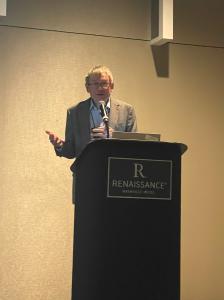Presented at the Indoor Environments Symposium, new research highlights the critical amount of radon variation in buildings for working vs. non-working hours.
— Dr. Tryggve Rönnqvist
LOMBARD, IL, UNITED STATES, November 28, 2023 /EINPresswire.com/ — New research confirms that follow-up radon measurements in schools and workplaces can have different results depending on the length of time of the follow-up measurement. This is mainly the result of buildings having time-controlled ventilation where it was discovered that radon levels during occupied hours are about one third of the levels during the entire measurement period.
This research was presented by Dr. Tryggve Rönnqvist, Technical Manager of Radonova Laboratories, at the recent Indoor Environments Association Radon and Vapor Intrusion Symposium in Nashville, Tennessee. Now in its 37th year, this annual event is the largest gathering of radon practitioners, researchers, regulators, and manufacturers in the United States. Dr. Rönnqvist’s research was entitled, “Radon Levels During Working and Non-Working Hours”.
In workplaces and schools with time-controlled ventilation, the differences between radon levels during working hours and nonworking hours can be large. Ventilation is often turned off or runs less during nights and weekends while windows and doors normally remain shut. According to the ANSI/AARST industry standards for non-residential buildings, it is recommended that radon be measured both during occupied and unoccupied hours.
Radon level differences and building ventilation
Rönnqvist’s research was conducted using Radonova’s continuous radon monitor, SPIRIT, to analyze the results of over 100 follow up radon measurements in Sweden for 2, 5 and, 7 day measurement periods. Only buildings with time controlled mechanical exhaust ventilation were used in the study. The long-term passive measurement results from Radonova Radtrak3 detectors were used together with the factor between occupied and unoccupied hours to get an estimated radon level during occupied hours.
The analysis showed that the radon levels during occupied hours in buildings with time-controlled ventilation, on average is one third of the radon levels during a full week average. The research also concluded that a follow-up measurement period of less than a full 7 days can either over or underestimate the radon conditions in a building. This could lead to not mitigating for radon when needed or, possibly, mitigating for radon unnecessarily.
This study highlights that the time when ventilation is started after weekends and evenings could have a large influence on the radon exposure to the people in the building. Starting the ventilation in the hours prior to a building being occupied can potentially reduce radon exposure. However, it should be noted that there are often people in schools and workplace buildings during unoccupied hours such as cleaning staff and other facility workers.
SPIRIT Continuous Radon Monitor
The SPIRIT radon sensor by Radonova used in this research is a highly sensitive radon measurement device for continuous monitoring of radon in real time together with other environmental parameters in homes, schools, and workplaces. The SPIRIT was used to obtain an average value of the radon during designated hours such as working and school hours. Such measurements are not typically possible with other simpler radon sensors that base results on the output from a 12 hour (or longer) average radon measurement. The SPIRIT also includes sensors for air pressure, temperature, humidity, and movement/tampering.
About Radonova
Radonova is the laboratory of choice for numerous government radon surveys, as well as other public, and private sector large-scale measurement contracts around the world. A truly global laboratory, Radonova is active in over 80 countries and has performed millions of radon measurements.
Zan Jones
Radonova
+1 331-814-2200
email us here
Visit us on social media:
Facebook
Twitter
LinkedIn
YouTube
![]()
Article originally published on www.einpresswire.com as Research Reveals How Much Radon Levels in Buildings Vary During Working and Non-Working Hours






